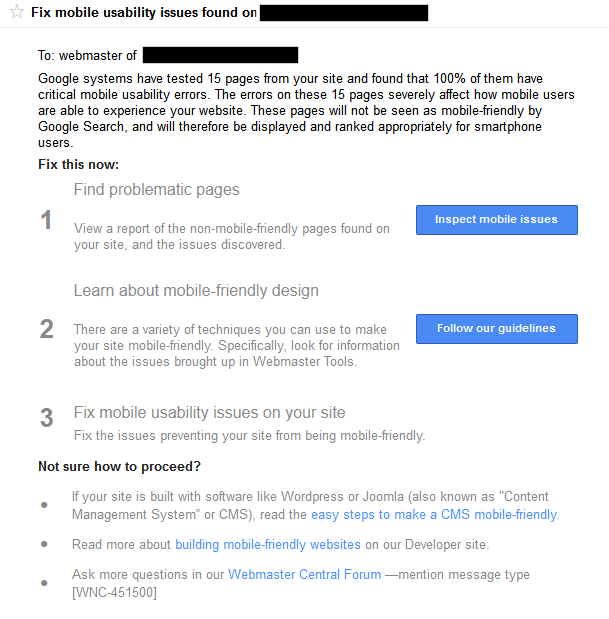When the mobile Internet age took flight with the debut of the iPhone in 2007, the digital marketing community began debating whether our clients now needed a dedicated mobile site or perhaps even a native mobile app. For most businesses, mobile usage was such a small percentage of overall traffic that the investment required to build an “m-dot” site was unjustifiable. Mobile users would just have to make do for a while, pinching and zooming on our sites with their touchscreens.
When responsive web design principles were popularized in 2010, the debate widened: should we build dedicated mobile sites or apps, or should we build a responsive site? Or should we hold tight until mobile traffic crossed a certain threshold that warranted the necessary investment?
As the debate raged into 2015, omnipotent Google calmly snapped its fingers and, in an instant, took the decision out of our hands.
With desktop browsing on the wane and mobile traffic now a majority of all web traffic, the mobile tipping point had surely been reached, Google reasoned. To make it official, on February 26, 2015, Google announced that, beginning April 21, 2015, their famed algorithm would expand its use of “mobile-friendliness as a ranking signal.” Oh, and “this change would have a significant impact in our search results.”
Uh oh.
So what does it mean? Quite simply, if your site isn’t mobile-optimized, and if you receive significant amount of search traffic from mobile devices, your traffic could plummet — in less than a month. Yikes. But surely Google wouldn’t pull the rug out from under a substantial subset of business owners so completely. Would they?
This is Probably a Good Development, But…
On one hand, it could be argued that Google is doing us all a favor by forcing us to take the mobile site plunge. Without some type of inducement, many companies were likely to go out of business in the years ahead, as thousands of stubborn business owners surely would refuse to invest in a mobile site. Even with this development, there are likely to be major losers no matter what happens. Digital media disrupts, dude. That’s what it does. (That mobile device just helped you to order that Uber car, right?)
On the other hand, this is yet another example of the extreme power Google wields over our digital lives. Should one company have so much power that they alone can make millions of businesses jump? Recent revelations show that despite choosing not to sue, antitrust regulators did produce detailed reports proving that Google manipulated SERP’s to harm direct competitors such as shopping engines. The FTC even wrote: “Staff concludes that Google’s conduct has resulted – and will result – in real harm to consumers and to innovation…” Those same regulators should be paying close attention to this algorithm change.
But of course, the real impetus behind the shift is more prosaic, more fueled by basic business logic than skulduggery: it’s about mobile advertising dollars. As consumers switch to mobile devices en masse, Google is waging a battle against declining ad revenues. Google’s not going to let your crappy old, non-mobile site drag them down any longer! If non-mobile sites crowd out the juicy top rankings, it’s entirely possible that mobile consumers could give up on Google search entirely and switch to the path of least resistance for site discovery, whatever that might be.
As so often happens, in shielding consumers from bad experiences, Google is also protecting its own long-term interests.
We Were Warned
We can’t say they didn’t warn us. Back on November 18, Google revealed a new addition to mobile search results. If a site passes Google’s “Mobile-Friendly Test,” it would receive a little gray designation that it was “Mobile-friendly,” like this:

The idea here being that mobile users could be assured that the search result was sure to offer a good mobile user experience. I have to admit that I now tend to favor “mobile-friendly” sites when I search on my iPhone.
Still, six months is hardly enough time for anyone to plan and build a mobile-optimized site. Google really should have given even more advanced warning of the mobile algo update, ideally as much as 12 or 18 months. Including the requisite corporate dithering, vendor searches, and project planning, and accounting for delays (delays are more common than not in any technical project, as brilliantly explained by Daniel Kahnemann in his research on the planning fallacy), that’s about how long it takes to rebuild a large site from the ground up. But Google may have reasoned that no one would have taken the news seriously given such a long time frame.
Part of me hopes the April 21 date will be postponed if enough businesses cry out for more time. A more realistic date would be late summer or early fall. Still, it’s wise to take Google at their word on this and plan accordingly.
As if to underscore the urgency of the upcoming algo update, Google has also been warning of the need to “fix mobile usability issues” via Google Webmaster Tools over the past week. If a verified site isn’t mobile-friendly, the site owner will see a message warning that, “Google systems have tested x number of pages from your site and found that 100% of them have critical mobile usability errors. The errors on these pages severely affect how mobile users are able to experience your website. These pages will not be seen as mobile-friendly by Google Search, and will therefore be displayed and ranked appropriately for smartphone users.” See below for the full message:

OK, so maybe they are serious about this!
For some of our SEO clients, mobile visits have almost reached parity with desktop visitors. Fortunately, most of these mobile-heavy client sites are already responsive and have passed Google’s Mobile-Friendly Test.
In another case, we had advised one of our ecommerce clients in early February to begin planning for a mobile version of their site soon. Little did we know that our recommendation would come less than six weeks before this new mobile algo were to hit. Their new mobile-friendly Magento-based site won’t launch this spring, but at least they’re on the right track to relaunch in late summer with a mobile-friendly layout. Happily, their organic Google traffic is in the 30% range, and climbing steadily.
Now What?
Want to learn how to go mobile, fast? Check out Part 2 of this article below, where I explain three of the fastest ways to redesign your site to be mobile-friendly:
Pass Google’s Mobile-Friendly Website Test with These 3 Website Platforms

